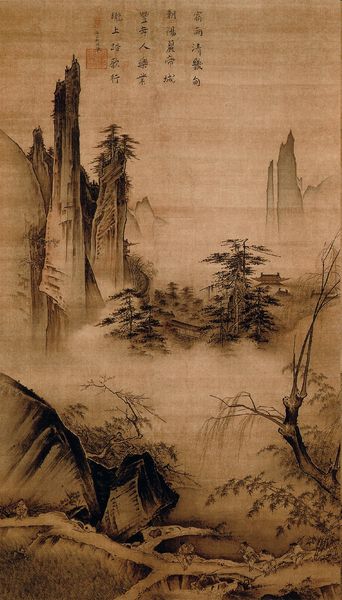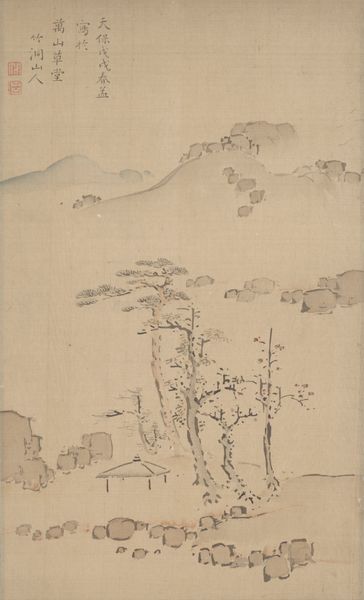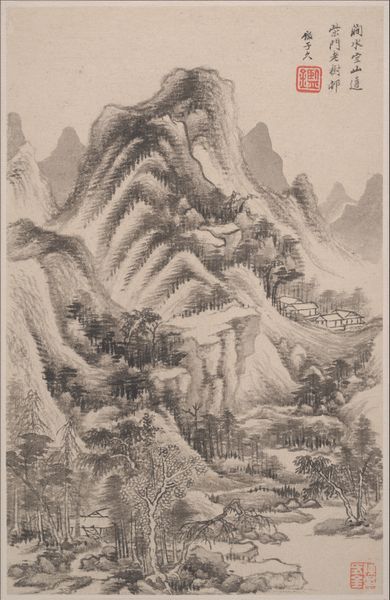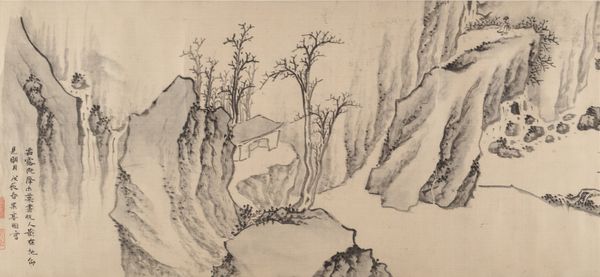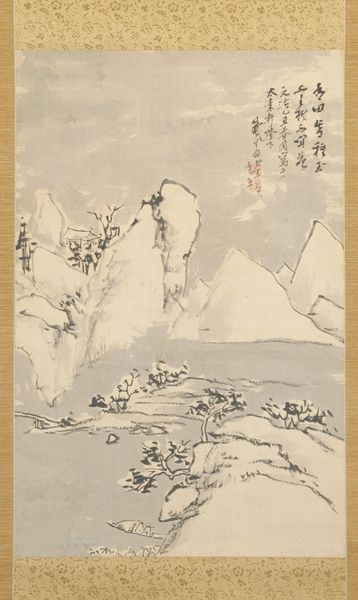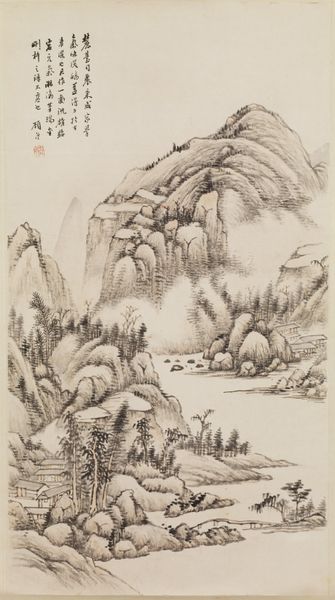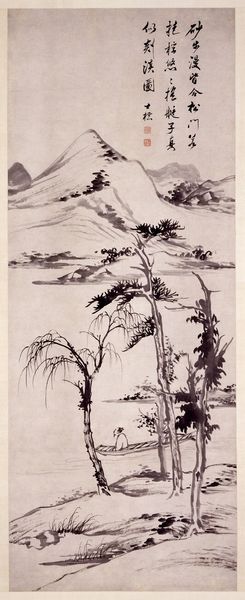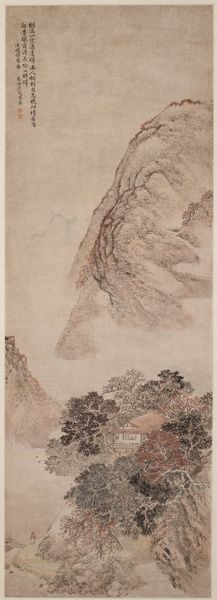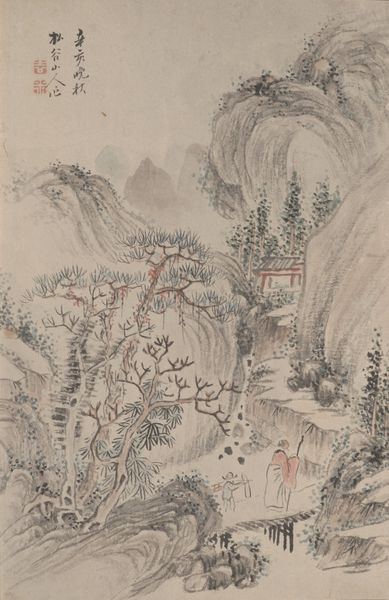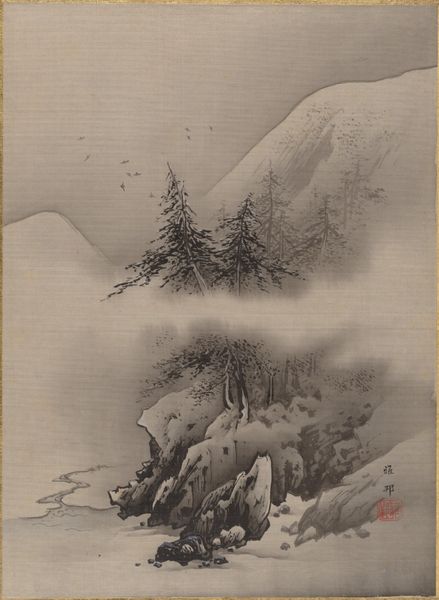
drawing, hanging-scroll, ink
#
drawing
#
asian-art
#
landscape
#
japan
#
form
#
hanging-scroll
#
ink
#
orientalism
#
line
#
calligraphy
Dimensions: 51 5/16 × 16 3/16 in. (130.33 × 41.12 cm) (image)77 15/16 × 21 3/8 in. (197.96 × 54.29 cm) (mount, without roller)
Copyright: Public Domain
Curator: This piece is "Landscape in the Manner of Ni Zan," an ink drawing on a hanging scroll, created around the 19th century, attributed to Yamanaka Shinten'ō. It's part of the Minneapolis Institute of Art's collection. Editor: Immediately, I’m struck by its quiet, contemplative nature. The monochromatic palette certainly contributes to this sense of stillness and almost feels dreamlike. Curator: Indeed. There's a sparseness to it, right? The composition, with the bare trees and distant mountains, evokes a feeling of solitude, a conscious aesthetic choice by the artist that echoes Ni Zan, an influential Yuan dynasty painter, known for his aloofness and purity of style. Editor: It does feel detached, perhaps even defiant in its simplicity. The almost complete lack of color amplifies the starkness, perhaps mirroring a societal detachment from nature or an elite resistance to societal change in 19th-century Japan. Do you think the emphasis on calligraphic lines lends it additional gravitas? Curator: I do. The calligraphy, almost integrated into the landscape, adds another layer of meaning. It is part of the aesthetic, and emphasizes how landscape paintings like this can be also forms of personal expression and cultural refinement. Editor: And what about the towering mountain, a common trope in Asian landscape painting? Curator: Mountains are so prevalent for a reason; they hold immense symbolic weight, often representing stability, longevity, and the connection between earth and heaven. In this case, I read it almost like a beacon, but somewhat ominous given the context of the broader, simplified landscape. The birds too, as well as the few dwelling below, act as counterpoints. Editor: I agree. And there's something subtly political in returning to these traditional themes when Japan was actively wrestling with Westernization during that period. It hints at preservation. How can it reassert and reaffirm a specific cultural identity and its ties to earlier traditions? Curator: Absolutely. I think both the landscape and the very *act* of painting in this "manner," which is to say copying and taking direct influence from, could speak to a deep nostalgia. A craving for something simpler and more authentically Japanese than modern, westernized life had become. Editor: A powerful observation. So this landscape becomes more than just scenery; it’s a coded commentary on cultural anxieties of its time. The past echoes, resisting the present. Curator: Precisely. And it invites us to consider the tension between tradition and change, nature and society. Editor: Ultimately, this image lingers long after the initial viewing. There's an enduring quality in its visual simplicity and symbolic richness that stays with us. Curator: Agreed. A modest picture with so much to say!
Comments
minneapolisinstituteofart about 2 years ago
⋮
The title of Yamanaka Shinten’ō’s work is reflected in the empty pavilion and the distancing of the background from the foreground, characteristics associated with the work of Ni Zan, however, the playful brushwork is the artist’s own. The inscription is ambiguous; perhaps Shinten’ō is congratulating himself for retaining his own style despite his comprehensive knowledge of classical Chinese painting; perhaps it is a lament for the perceived fall of nanga into stale academicism that occurred again and again through history. Inscription 予画本無宗傳惟以山川為筆墨似雲烟為渲染幾處冩之於此有餘師 My painting originally had no sect or doctrine, I just rely on mountains and rivers for my brush and ink, clouds and mist for tones and shadings, so wherever I go to sketch, I have many teachers. (Transl. by Steven Addiss 1993)
Join the conversation
Join millions of artists and users on Artera today and experience the ultimate creative platform.
